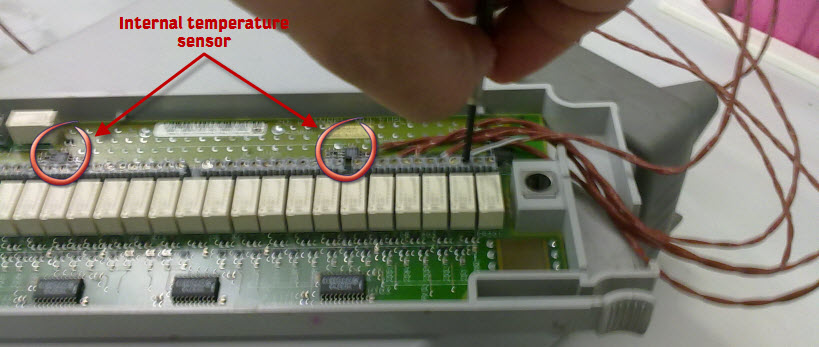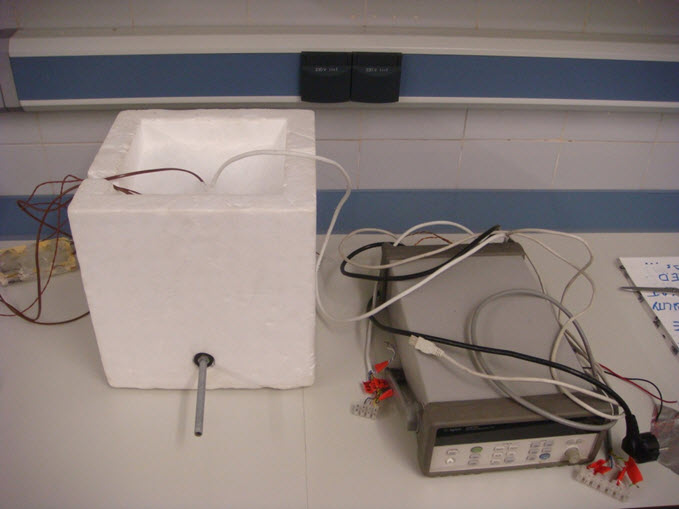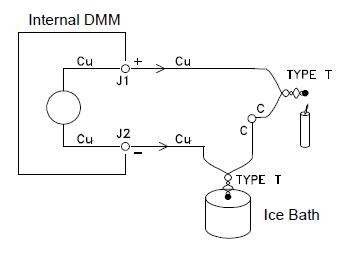Team:Valencia/TMS
From 2010.igem.org
Alejovigno (Talk | contribs) |
Alejovigno (Talk | contribs) (→Ice bath thermocouple compensation) |
||
| (7 intermediate revisions not shown) | |||
| Line 4: | Line 4: | ||
<div id="HomeCenter"> | <div id="HomeCenter"> | ||
{{Team:Valencia/to_wb}} | {{Team:Valencia/to_wb}} | ||
| - | |||
<div id="Titulos"> | <div id="Titulos"> | ||
Temperature measurement system | Temperature measurement system | ||
| Line 21: | Line 20: | ||
In order to use this system is necessary to connect it to a electronic acquisition system. In the new | In order to use this system is necessary to connect it to a electronic acquisition system. In the new | ||
connection places appear new thermocouple junctions (J1 and J2 in Figure 1) which modify the original | connection places appear new thermocouple junctions (J1 and J2 in Figure 1) which modify the original | ||
| - | voltage difference | + | voltage difference with the following expresion: |
| + | |||
| + | <center> | ||
| + | <span style="text-align: center;"> | ||
| + | V<sub>''measured''</sub> = V<sub>''real''</sub>(T<sub>j</sub>) | ||
| + | + V<sub>''error''</sub>(T<sub>j1</sub>) + V<sub>''error''</sub>(T<sub>j2</sub>)</span> | ||
| + | </center> | ||
| + | |||
| + | |||
| + | The are several strategies to deal with this problem. | ||
The electronic acquisition system that we use is the Datalogger | The electronic acquisition system that we use is the Datalogger | ||
| Line 58: | Line 66: | ||
expel the liquid water. | expel the liquid water. | ||
| - | == | + | == Experimental assay== |
| - | In our particular case, we selected a | + | In our particular case, we selected a J type thermocouple |
(Copper-Constantan), because one of its metals is copper | (Copper-Constantan), because one of its metals is copper | ||
already, and then there is only one extra junction in the | already, and then there is only one extra junction in the | ||
| Line 68: | Line 76: | ||
4. Practical implementation.]] | 4. Practical implementation.]] | ||
| - | + | Here we have: | |
| + | |||
| + | <span style="text-align:center;"> | ||
| + | V<sub>''measured''</sub> = V<sub>''real''</sub>(T<sub>j</sub>) | ||
| + | + V<sub>''error''</sub>(T<sub>j2</sub>)</span> | ||
| + | |||
| + | |||
| + | Then the practical implementation will also be easier with the | ||
selected configuration. | selected configuration. | ||
Latest revision as of 13:56, 26 October 2010
Time goes by...
(El tiempo pasa...)
Follow us:

Our main sponsors:

Our institutions:

Visitor location:
» Home » The Project » Creating Technologies » Microbial Albedo Recorder
Temperature measurement system
Ice bath thermocouple compensation
Our temperature measurement system is based on the Seebeck effect. The Seebeck effect happens when a junction of two different metals is exposed to a certain temperature. In the loose ends of the wires appears a difference of voltage proportional to the that temperature. Measuring the generated voltage is possible to determine the temperature which generated de effect. This is done by means of polynomial interpolation (compatible with the ITS-90 standard).
In order to use this system is necessary to connect it to a electronic acquisition system. In the new
connection places appear new thermocouple junctions (J1 and J2 in Figure 1) which modify the original
voltage difference with the following expresion:
Vmeasured = Vreal(Tj) + Verror(Tj1) + Verror(Tj2)
The are several strategies to deal with this problem.
The electronic acquisition system that we use is the Datalogger 34970A (Agilent). This device has the possibility to deal the already mentioned problem with two different strategies.
- Automatic compensation
- Fixed compensation
Automatic Compensation
The automatic compensation is made internally by the device, measuring the surrounding temperature of the copper junctions, with solid state sensors. This is a very simple option, but its precision is very low, and inadequate for our purpose.
Fixed Compensation
The fixed compensation however requires the introduction of another subsystem: an ice bath. Inside this bath, the coper wire/thermocouple confection is made. So, this is a known and fixed junction, which its temperature is introduced to the datalogger during the setup.
This methods is a very precise however it has a huge inconvenient: the temperature of the bath has to be CONSTANT. In order to ensure this though the hole experiment duration, we used a sufficiently big ice mass. Also we added a drain, to expel the liquid water.
Experimental assay
In our particular case, we selected a J type thermocouple (Copper-Constantan), because one of its metals is copper already, and then there is only one extra junction in the connection.
Here we have:
Vmeasured = Vreal(Tj) + Verror(Tj2)
Then the practical implementation will also be easier with the
selected configuration.
A simple experiment was carried out with both automatic and fixed compensation: the measure of the temperature of the ice.
In Figures 6, the obtained results are shown and is possible to
see the error of the automatic compensation and how is worth to
make an extra effort in the practical implementation.
 "
"





